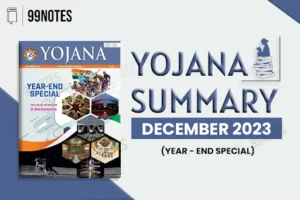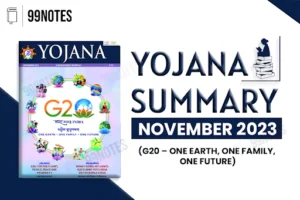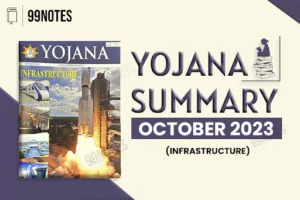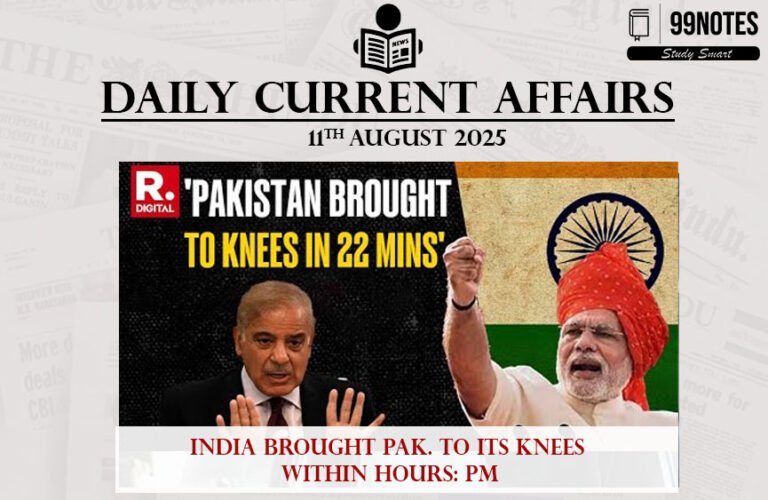14 Feb 2024 : Daily Current Affairs
Daily Current Affairs
14-February-2024- Top News of the Day
1. Farmers Demand Legal Guarantee for MSP Amidst Ongoing Committee Deliberations
| Topic: GS3 – Agriculture – MSP This topic is relevant for both Prelims and Mains in the context of understanding the dynamics of MSP, farmer protests, and government initiatives to address agricultural challenges. |
| Context: |
|
More about the news:
Formation and Composition of the Committee:
- The committee, appointed by the Centre in July 2022, focuses on promoting zero-budget farming, changing crop patterns, and enhancing MSP transparency.
- Chaired by former agriculture secretary, it comprises 26 members, including representatives from NITI Aayog, agricultural economists, farmers’ organizations, and government officials.
Absenteeism of Key Stakeholders:
- Despite provisions for representation from farmers’ unions like the Samyukta Kisan Morcha (SKM), pivotal in the 2020-21 protests, no SKM members joined the committee.
- Currently, protesters marching to Delhi belong to the Kisan Mazdoor Morcha (KMM) and Samyukta Kisan Morcha (non-political), a breakaway faction of SKM.
Purpose and Mandate of the Panel:
- Initially announced by PM Modi in November 2021, the committee aims to address concerns related to zero-budget farming, crop diversification, and MSP effectiveness and transparency.
- Its mandate includes suggesting measures to strengthen the agricultural marketing system and enhance the autonomy and scientific basis of the Commission for Agricultural Costs and Prices.
Progress and Tenure of the Committee:
- The committee on MSP convened its first meeting in August 2022 and continues to actively deliberate on its assigned subjects.
- However, the absence of a specified tenure means the committee faces no formal deadline for submitting its recommendations.
Conclusion:
- While farmers demand immediate legal assurances for MSP, the committee appointed by the Centre continues its efforts to enhance MSP effectiveness and transparency, alongside broader agricultural reforms.
- The contrasting approaches underscore the complexities surrounding agricultural policy and the imperative for inclusive stakeholder engagement to address farmers’ concerns effectively.
| Issue of Minimum Support Price (MSP) in India |
Objectives:
Background:
Crops covered:
Associated issues:
|
| PYQ: Consider the following statements: (2023) 1) The Government of India provides Minimum Support Price for niger (Guizotia abyssinica) seeds. 2) Niger is cultivated as a Kharif crop. 3) Some tribal people in India use niger seed oil for cooking. How many of the above statements are correct? (a) Only one (b) Only two (c) All three (d) None Ans: (c) |
| Practice Question: Discuss the challenges and implications of farmers’ demands for a legal guarantee for minimum support prices (MSP) amidst ongoing committee deliberations. (150 words/10 m) |
2. Bengaluru’s NAL Achieves Breakthrough in HAPS Technology with Solar-Powered UAV Prototype
| Topic: GS3 – Science & Technology – Achievements of Indian S&T; Indigenization of technology This topic is relevant for both Prelims and Mains in the context of understanding India’s advancements in aerospace technology, including the development of high-altitude pseudo-satellite vehicles (HAPS). |
| Context: |
|
More about the news:
Potential Utility of HAPS:
- HAPS vehicles, such as the prototype developed by NAL, hold significant promise for surveillance, monitoring, and disaster management purposes.
- Unlike traditional UAVs, which have limited endurance and coverage, and satellites, which may lack constant surveillance capabilities, HAPS offer the advantage of extended flight duration, sustained presence, and high-resolution monitoring over large areas.
Engineering Challenges and Technological Advances:
- Despite their potential, HAPS vehicles pose significant engineering challenges, including generating sufficient solar power, ensuring operational continuity through night periods, and maintaining stability in the stratosphere.
- NAL’s prototype aims to address these challenges with advanced solar cells, batteries, and lightweight composite materials.
- Achieving high energy density batteries, capable of powering the aircraft through extended flight durations, remains a critical focus area.
India’s Early Entry into HAPS Technology:
- India’s foray into HAPS technology represents an early-stage entry into a burgeoning field, offering opportunities for capacity building, patent control, and business development.
- Experts leading the development at NAL, believes that India’s timely entry into HAPS technology positions it as a competitive player in the global arena.
- Additionally, India’s tropical climate presents unique challenges, offering opportunities for innovation and advancement in HAPS technology, potentially surpassing the achievements of other countries in this domain.
| What is High Altitude Pseudo-Satellite (HAPS)? |
About:
|
| PYQ: What is “Terminal High Altitude Area Defense (THAAD)”, sometimes seen in the news? (2018) (a) An Israeli radar system (b) India’s indigenous anti-missile programme (c) An American anti-missile system (d) A defence collaboration between Japan and South Korea Ans: (c) |
| Practice Question: Discuss the significance of Bengaluru’s National Aerospace Laboratories (NAL) achieving a breakthrough in High-Altitude Pseudo-Satellite (HAPS) technology with the successful flight of a solar-powered UAV prototype. (150 words/10 m) |
3. Former US President Trump Sparks Controversy with Remarks on NATO Defense Commitments
| Topic: GS2 – International Relations – Important International institutions This topic is relevant for both Prelims and Mains in the context of understanding the dynamics of international alliances such as NATO. |
| Context: |
|
More about the news:
Understanding NATO:
- Founded in 1949 during the Cold War era to counter the Soviet Union, the North Atlantic Treaty Organization (NATO) is a political and military alliance comprising countries from North America and Europe.
- NATO currently consists of 31 members, primarily European nations, alongside the United States and Canada.
- Finland, the most recent addition, joined in April last year.
Trump’s Statements on NATO:
- During his tenure as US President, Trump frequently criticized NATO and its members, particularly Germany, for insufficient defense spending and dependence on the United States for protection.
- At a recent campaign rally, Trump recounted a conversation with an unnamed foreign leader, suggesting that he would not defend NATO allies who failed to fulfill their financial obligations.
NATO Funding Mechanism:
- Contrary to Trump’s portrayal, NATO operates differently from a traditional club with membership fees.
- While it does have common funds to which all members contribute, the alliance’s strength primarily relies on national defense spending by its members, with each nation committing to spending at least 2% of its Gross Domestic Product (GDP) on defense annually.
Significance of NATO’s Article 5:
- Article 5 of the NATO treaty states that an armed attack against one or more members shall be considered an attack against all, requiring collective defense measures.
- However, Article 5 does not mandate an automatic military response, relying instead on political leaders’ commitment to taking necessary action, which is why Trump’s remarks stirred controversy by undermining the perceived strength of Article 5.
Implications of Trump’s Comments:
- Trump’s suggestion that he would not necessarily uphold NATO’s collective defense principle weakens the alliance’s credibility and raises doubts about the mutual commitment among member states, potentially undermining the deterrence against external aggression that NATO aims to provide.
| PYQ: The expansion and strengthening of NATO and a stronger US-Europe strategic partnership works well for India.” What is your opinion about this statement? Give reasons and examples to support your answer. (250 words/15m) (UPSC CSE (M) GS-2 2023) |
| Practice Question: Evaluate the significance of NATO’s Article 5 and its role in ensuring mutual defense among member states, and analyze the challenges posed by divergent perspectives within the alliance. Assess the implications of such controversies for India’s foreign policy and strategic interests in the context of evolving international relations.Top of Form (250 words/15 m) |
4. India and UAE Strengthen Bilateral Ties Through Multifaceted Agreements and Symbolic Gestures
| Topic: GS2 – International Relations – Bilateral Relations This topic is relevant for both Prelims and Mains in the context of India’s relationships with key strategic partners like the UAE. |
| Context: |
|
More about the news:
Investment and Economic Cooperation:
- The signing of a Bilateral Investment Treaty and a Comprehensive Economic Partnership Agreement underscores the commitment of both countries to promote investments and economic collaboration.
- UAE’s significant investments in India, particularly in the infrastructure sector, highlight the growing economic ties between the two nations.
- The intergovernmental framework agreement on the India-Middle East Economic Corridor further strengthens regional connectivity and fosters cooperation in trade and infrastructure development.
Digital Payment Platforms and Financial Cooperation:
- The agreements on interlinking digital payment platforms like UPI (India) and AANI (UAE) facilitate seamless cross-border transactions, while the pact on interlinking domestic debit/credit cards enhances financial sector cooperation.
- Modi’s appreciation for the launch of UAE’s domestic card JAYWAN, based on the digital RuPay card stack, reflects efforts to promote universal acceptance of RuPay across the UAE.
Energy and Infrastructure Collaboration:
- The signed agreements in the energy sector, including cooperation in electrical interconnection and trade, aim to enhance energy security and promote energy trade between India and the UAE.
- Collaboration in digital infrastructure projects and cultural initiatives, such as heritage preservation and museum cooperation, further strengthens bilateral ties.
Symbolic Gestures and Cultural Exchange:
- Modi expressed gratitude for the UAE’s support in granting land for the construction of the BAPS Temple in Abu Dhabi, highlighting the temple’s significance in celebrating UAE-India friendship and cultural bonds.
- The inauguration of the temple symbolizes the UAE’s commitment to harmony, tolerance, and peaceful coexistence.
Future Engagements:
- Modi’s address at the World Government Summit and the inauguration of the BAPS Temple mark significant milestones in India-UAE relations.
- These engagements underscore the depth of bilateral cooperation and pave the way for further collaboration between the two countries.
| PYQ: How will I2U2 (India, Israel, UAE and USA) grouping transform India’s position in global politics? (250 words/15m) (UPSC CSE (M) GS-2 2022) |
| Practice Question: How do the recent bilateral agreements and diplomatic engagements between India and the UAE signify a significant milestone in India’s foreign relations? (250 words/15 m) |
5. ‘Specific duration’ clause in draft India-EFTA pact may affect drug industry
| Topic: GS3 – Indian Economy – Issues relating to IPR GS2 – International Relations – Bilateral Relations Crucial for UPSC as it involves India’s stance on intellectual property, impacting access to affordable medicines and global trade negotiations. |
| Context |
| ● The leaked draft of the India-EFTA Free Trade Agreement reveals a clause potentially delaying access to affordable generic drugs in India by six years, raising concerns about drug availability. |
Additional information on this news:
- A leaked draft of the India-EFTA Free Trade Agreement reveals a clause potentially delaying generic drug access in India by six years.
- The Trade and Economic Partnership Agreement (TEPA) requires a specific duration wherein drug applicants cannot rely on undisclosed test data for market approval.
- The clause covers both ‘new’ chemical drugs and complex ‘biologics drugs’ like monoclonal antibodies and vaccines, posing challenges for Indian biotech firms.
- India’s resistance stems from its thriving generics industry, producing over 60,000 drugs across 60 categories.
- The clause may impact the availability of essential drugs, raising concerns about affordability and access.
- Intellectual property concerns, including patent rights and data exclusivity, remain key challenges in the negotiations.
| Significance of India – EU EFTA |
● Economic growth:
● Strategic relations:
● Technology and innovation:
● Global trade landscape:
|
| PYQ: How is the government of India protecting traditional knowledge of medicine from patenting by pharmaceutical companies? (250 words/15m) (UPSC CSE (M) GS-3 2019) |
| Practice Question: How does the proposed clause in the India-EFTA Free Trade Agreement impact India’s pharmaceutical industry and access to affordable medicines? Discuss. (150 words/10 m) |
6. MEA told to monitor organ transplantation process for foreigners
| Topic: GS2 – Governance – Government Policies Relevant for UPSC as it involves health governance, international relations, and legal frameworks regarding organ transplantation, reflecting broader ethical and legal considerations. |
| Context |
| ● Health Secretary alerts Ministry of External Affairs on potential violations in organ transplantation by foreigners in India, citing concerns over document authenticity and seeks measures for monitoring and compliance. |
Additional information on this news:
- Health Secretary Apurva Chandra alerts Ministry of External Affairs about potential violations in organ transplantation by foreigners in India.
- Concerns raised over the veracity of documents establishing relationships between donors and recipients, identity proof, and residency.
- Foreign nationals visiting India for organ transplants may face issues with the authenticity of their documents.
- Chandra requests dissemination of rules under the Transplantation of Human Organ and Tissues Act, 1994, to all foreign embassies and missions in India.
- The Ministry seeks the identification of nodal officers for coordinating organ donation and transplantation processes for foreigners.
- Measures aimed at preventing commercial dealings in organ or tissue transplants and ensuring compliance with regulations.
| Organ Transplantation Industry in India: Violations by Foreign Individuals |
Demand-Supply Imbalance:
Foreign Individuals and Violations:
Specific Violations:
Impacts:
Efforts to Combat Violations:
Overall:
|
| Practice Question: How does the Indian government address challenges in organ transplantation by foreigners? Discuss the legal, ethical, and diplomatic dimensions (150 words/10 m) |
7. The many lows of the 17th Lok Sabha
| Topic: GS2 – Indian Polity – Parliament Critical for UPSC as it addresses the erosion of parliamentary efficiency, legislative scrutiny, and the urgent need for comprehensive reforms. |
| Context |
| ● The article highlights concerning trends in the 17th Lok Sabha, citing a decline in parliamentary efficiency, legislative scrutiny, and tools for executive accountability, emphasizing the need for urgent reforms. |
Additional information on this news:
- The 17th Lok Sabha witnessed notable shortcomings in parliamentary functioning, including the absence of a Deputy Speaker and the lowest number of sittings.
- Regrettable firsts include passing significant legislation with over 70% of Opposition MPs suspended and minimal participation from the Prime Minister in question sessions.
- A declining trend in parliamentary efficiency spans more than 30 years, with the annual average of Bills passed dropping from 65 (1952-1990) to 48 (1991-2023).
- The 17th Lok Sabha sent only 16% of Bills for scrutiny, marking the lowest in the last four Lok Sabhas.
- Decreased sitting days and hours in Lok Sabha limit debates and diminish MPs’ participation, with the 17th Lok Sabha having the least number of sittings (274).
- The use of parliamentary tools for executive accountability has significantly decreased, including half-hour discussions, short duration discussions, calling attention, and adjournment motions.
- Time spent on discussing crucial matters like the Union Budget, Ministry-wise demands, and the Finance Bill has substantially declined post-1990.
| Declining Efficacy of Parliament |
Reasons:
Implications:
Way Forward:
|
| PYQ: Individual Parliamentarian’s role as the national lawmaker is on a decline, which in turn, has adversely impacted the quality of debates and their outcome. Discuss. (250 words/15m) (UPSC CSE (M) GS-2 2019) |
8. Too many IITs lead to unrealistic expectations and quality problems
| Topic: GS2 – Social Justice – Education Relevant for UPSC as it addresses challenges in maintaining the global reputation of IITs, necessitating strategic reforms and international collaborations. |
| Context |
| ● The article discusses concerns over the declining standards of Indian Institutes of Technology (IITs) due to rapid expansion, faculty shortages, and the need for strategic restructuring and international collaboration. |
Concerns about IIT Standards:
- IITs, the crown jewels of Indian higher education, face a decline in standards due to rapid expansion and potential dilution of the “IIT brand.”
- The recent decision by the University Grants Commission to allow select IITs to set up campuses abroad raises concerns about further weakening the institutions.
Historical Overview:
- The original five IITs, established in the 1950s and 1960s, focused on technology and engineering, gradually adding humanities and social sciences.
- Currently, there are 23 IITs, with significant expansion occurring after 1990, often resulting from upgrading existing institutions.
Challenges in Faculty and Facilities:
- IITs struggle with a shortage of professors, and many positions remain unfilled, affecting the quality of education.
- Attracting top-quality faculty has become challenging, with emerging IT industries in India offering more lucrative opportunities.
Impact of Expansion:
- The government’s expansion of IITs, spreading them across the country, poses challenges in maintaining “world-class” quality and dilution of the “IIT brand.”
- New IITs in smaller towns face difficulties in offering urban amenities and may lack sufficient top-quality faculty.
Need for Restructuring:
- Proposes restructuring IITs with perhaps 10 to 12 real IITs located near major cities and renaming others with sufficient resources for quality education and research.
- Emphasizes the importance of a more limited, well-funded “IIT system” with “world-class” faculty and sustained funding.
Internationalization and Collaboration:
- Recommends internationalization efforts beyond overseas branches, focusing on collaborations with global universities and attracting international students.
- Cites examples like IIT Bombay-Monash Research Academy and University of Queensland-IIT Delhi Academy of Research as promising models.
Call for Adequate Funding:
- Stresses the need for sustained funding from the government and philanthropy to maintain the IITs’ status as India’s most recognizable and respected academic institutions.
- Warns against overexpansion, which could diminish the quality and reputation of IITs.
Conclusion:
- In conclusion, the article highlights the imperative need for strategic restructuring, focusing on a limited number of real IITs, attracting top-tier faculty, fostering international collaborations, and securing sustained funding to preserve the prestigious stature of IITs.
| Practice Question: How can India address the challenges faced by Indian Institutes of Technology (IITs) in maintaining global standards and reputation? Discuss reforms and strategies. (150 words/10 m) |
For Enquiry

14 February 2024 : The Hindu Editorial Notes PDF

14 Feb 2024 : Daily Current Affairs

14 Feb 2024 : Indian Express Editorial Analysis

14 February 2024 : PIB Summary for UPSC

Yojana Magazine Summary December 2023: Year End Special

Yojana Magazine Summary November 2023: G20 – One Earth, One Family, One Future

Yojana Magazine Summary October 2023- Infrastructure

13 Feb 2024 : Daily Current Affairs Quiz

13 Feb 2024 : Daily Answer Writing

13 Feb 2024 : Daily Current Affairs
Feb 2024 The Hindu 14 February 2024 : The Hindu Editorial Notes PDF The Hindu Editorial
14-February-2024
1. Old-fashioned trust and credibility bind India-UAE ties.
Topic:…
Daily Current Affairs 14 Feb 2024 : Daily Current Affairs Daily Current Affairs
14-February-2024- Top News of the Day
1. Farmers Demand Legal Guarantee for MSP…
Indian Express 14 Feb 2024 : Indian Express Editorial Analysis Indian Express Editorial Analysis
14-February-2024
1. An Arabian Valentine
Topic: GS2 – International…
feb 2024 PIB 14 February 2024 : PIB Summary for UPSC PIB Summary for UPSC
14-February -2024
1. A new method for sodium catalyzed synthesis of carbon nanotubes…
Yojana Summary Yojana Magazine Summary December 2023: Year End Special Yojana Magazine Summary December 2023
Yojana magazine is monthly magazine published by government of…
Yojana Summary Yojana Magazine Summary November 2023: G20 – One Earth, One Family, One Future Yojana Magazine Summary November 2023
Yojana magazine is monthly magazine published by government of…
Yojana Summary Yojana Magazine Summary October 2023- Infrastructure Yojana Magazine Summary September 2023
Yojana magazine is monthly magazine published by government of…
Daily Quiz 13 Feb 2024 : Daily Current Affairs Quiz 13 Feb 2024 : Daily Quiz…
mains answer writing 13 Feb 2024 : Daily Answer Writing Mains Answer Writing
13-February-2024
Q1) With the help of a map, show major ocean currents of the world….
Daily Current Affairs 13 Feb 2024 : Daily Current Affairs Daily Current Affairs
13-February-2024- Top News of the Day
1. Indian Navy Personnel Released from Custody…

